Among the first words out of my two year-old son’s mouth every morning are, “Can I have a banana?” He’ll eat five a day if allowed. So I’m hearing the call to get better about growing them in the yard.
Here in Southern California? Can they really produce?
Good climate for bananas
Bananas can be grown well and easily throughout most of Southern California between the mountains and the ocean, specifically Sunset Zones 24 down to 21 (find your Sunset zone here). Think of the areas that the marine layer consistently rolls over each summer night. This is where it’s a suitable combination of humidity and winter warmth.
I’ve grown bananas within this ideal band.
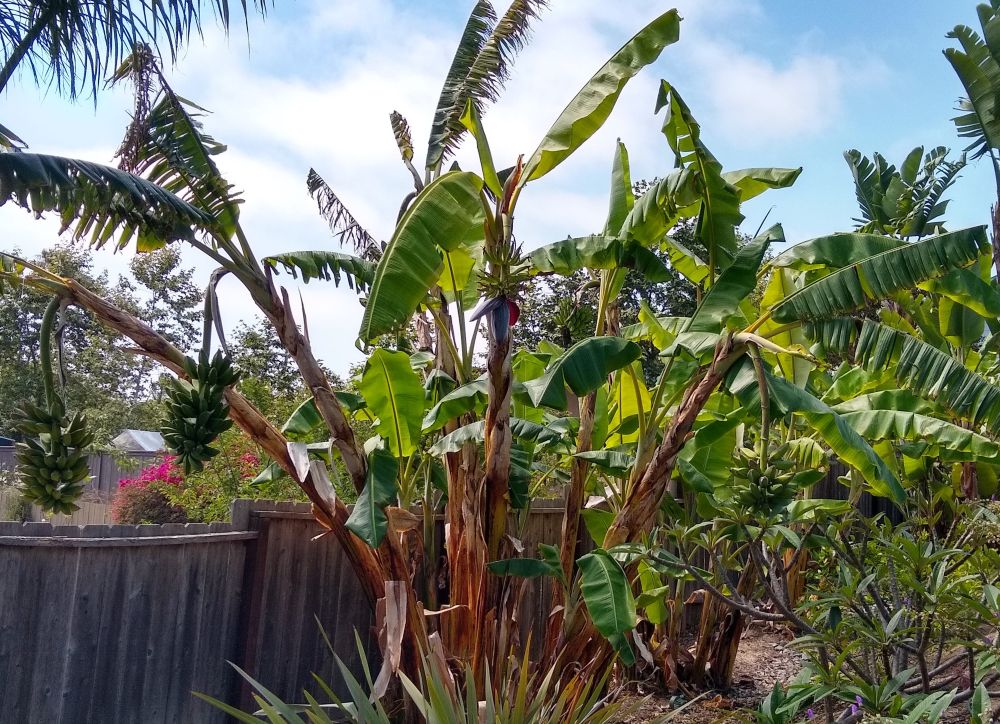
I’m now in the foothills, Sunset Zone 20, where we get at least a touch of frost every winter. Bananas don’t like frost, of course. Here I’ve learned to put my bananas near a south-facing wall for the best frost protection. (Mere frost won’t kill a banana plant, but it does slow down its fruit production by damaging leaves.)
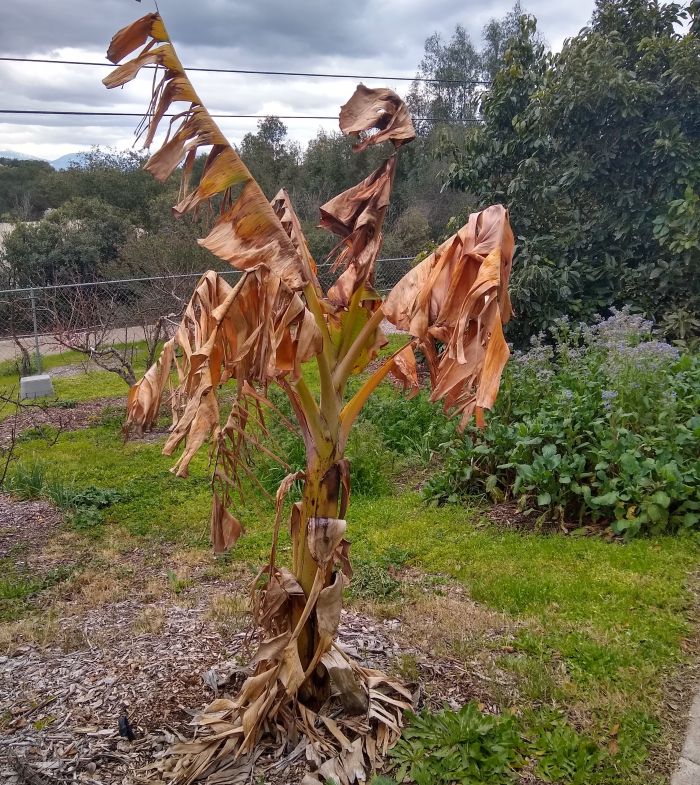
I’ve seen good banana bunches on plants farther north and in cool, coastal locations too. Here’s a producing mat of banana plants in Carpinteria, Santa Barbara County.
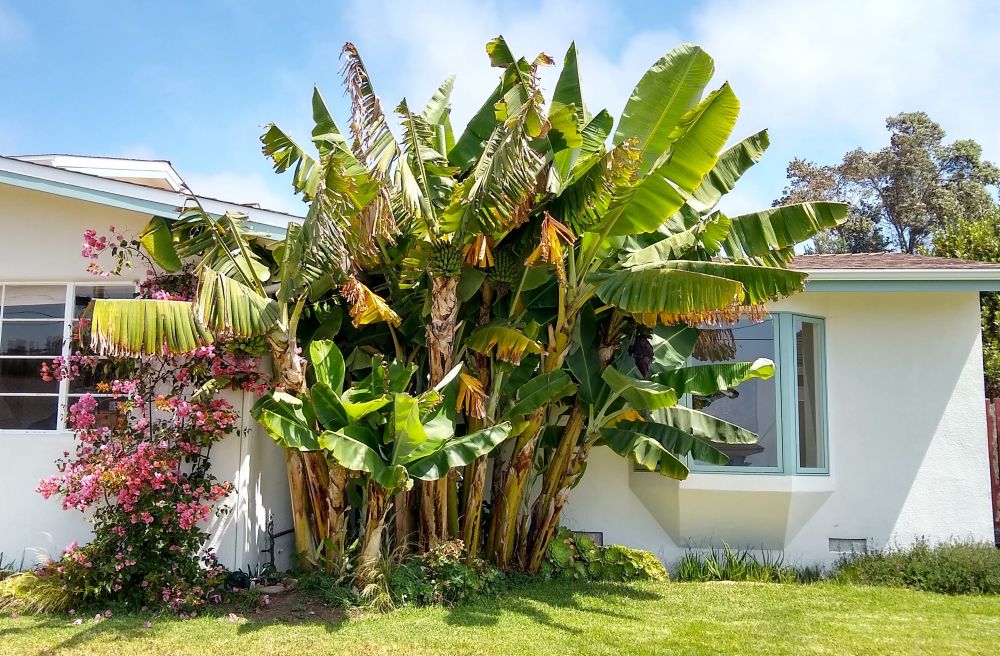
It’s generally helpful for bananas to grow where the wind is not strong. This is for two reasons: they look better (leaves get tattered in wind), and the wind draws moisture out of the leaves. But being out of the wind is certainly not necessary for fruit production.
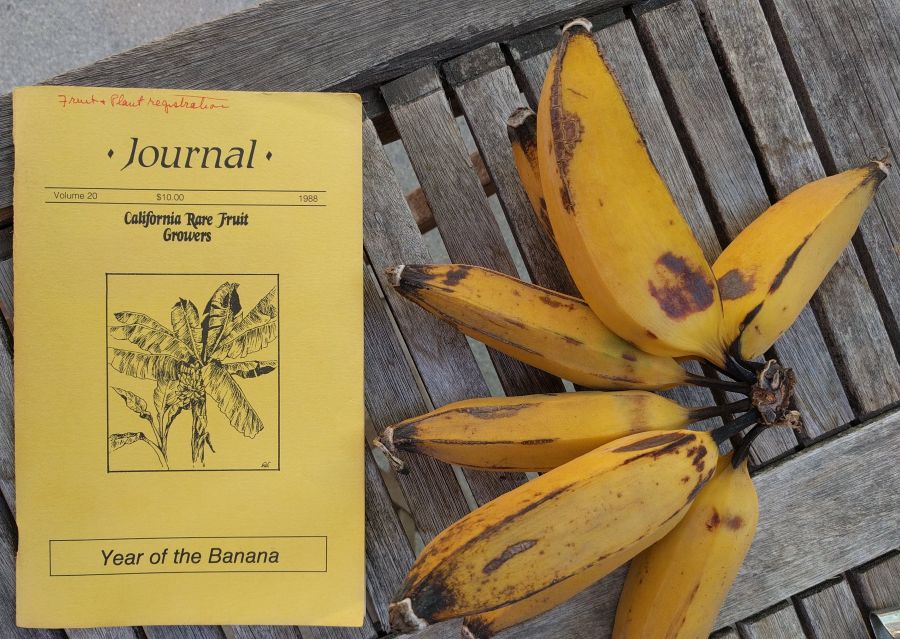
How banana plants grow
Banana plants aren’t individuals like, say, tomato plants. Neither are banana plants trees like, say, orange trees. Banana plants are more like giant stalks of grass. New leaves form in the center of the plant stalk, where they are rolled up like a cigar, and then emerge and unfurl above the older leaves.
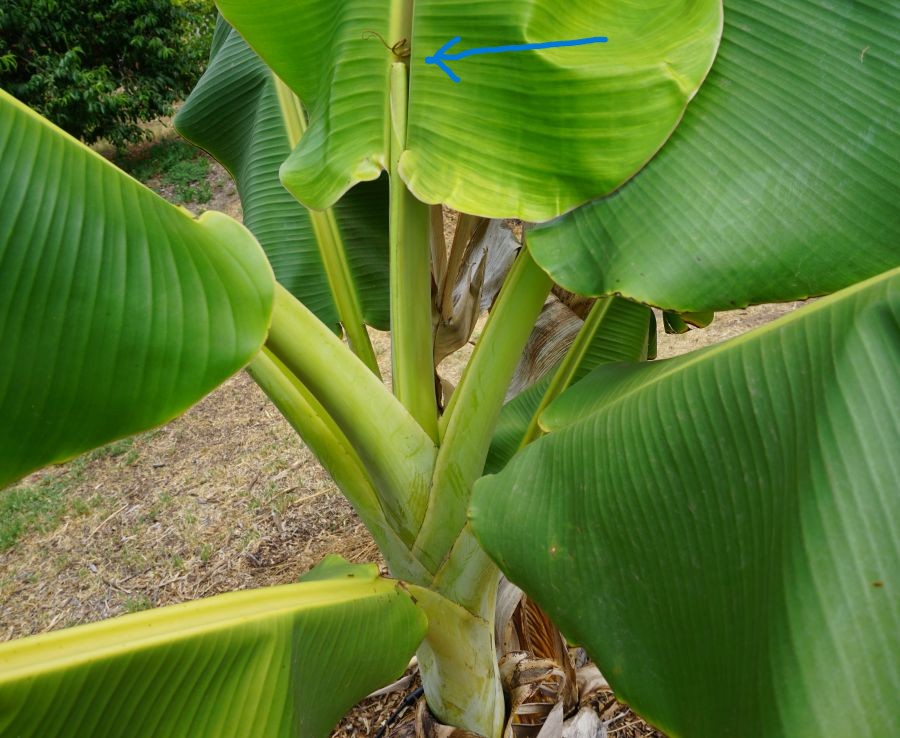
The banana plant continues to unfurl around 40 new leaves at which time an obviously shorter leaf emerges. This is called a flag leaf.
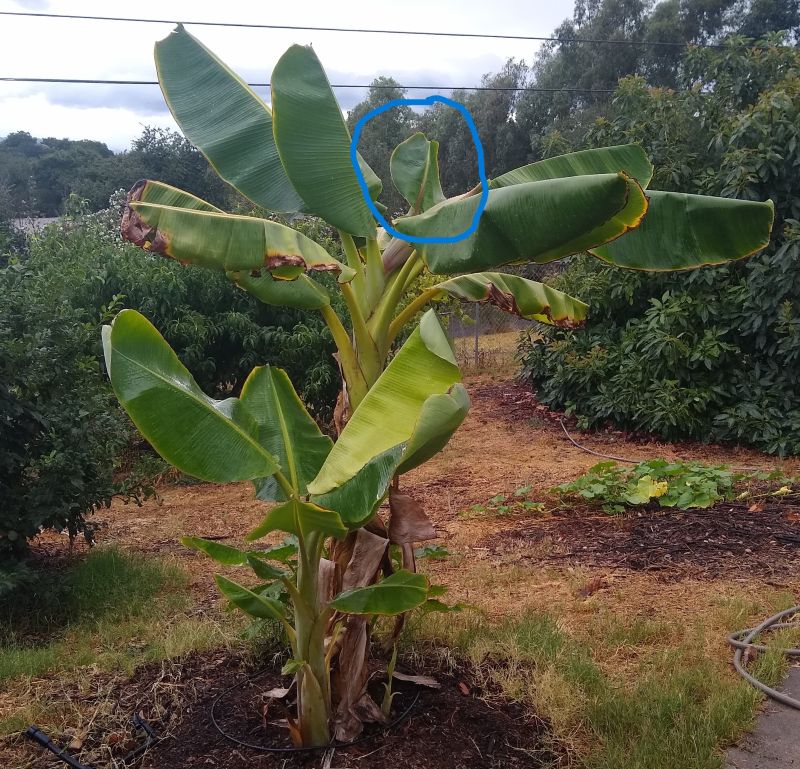
The flag leaf indicates that the plant is next going to flower. Then out of the center comes a final, small and narrow leaf, and then a purple flower bud.

The flower bud lengthens. It has purple leaves that are technically bracts, and under each are groups of flowers that can become banana fruit.
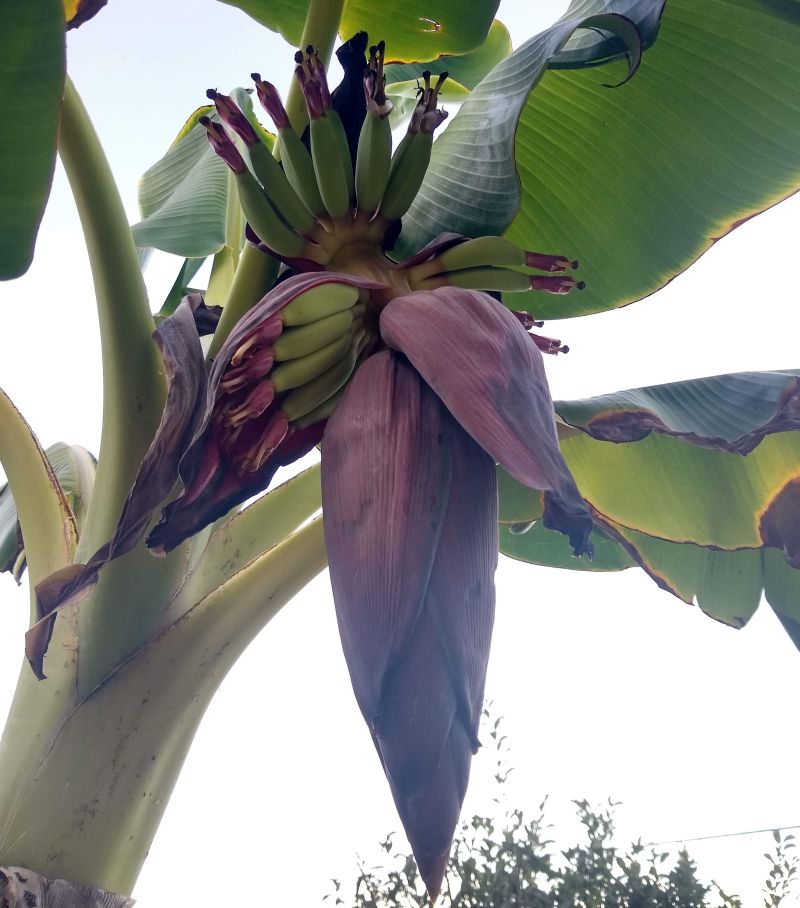
Eventually you have what looks like the bunch of bananas you may have seen in pictures or drawings.
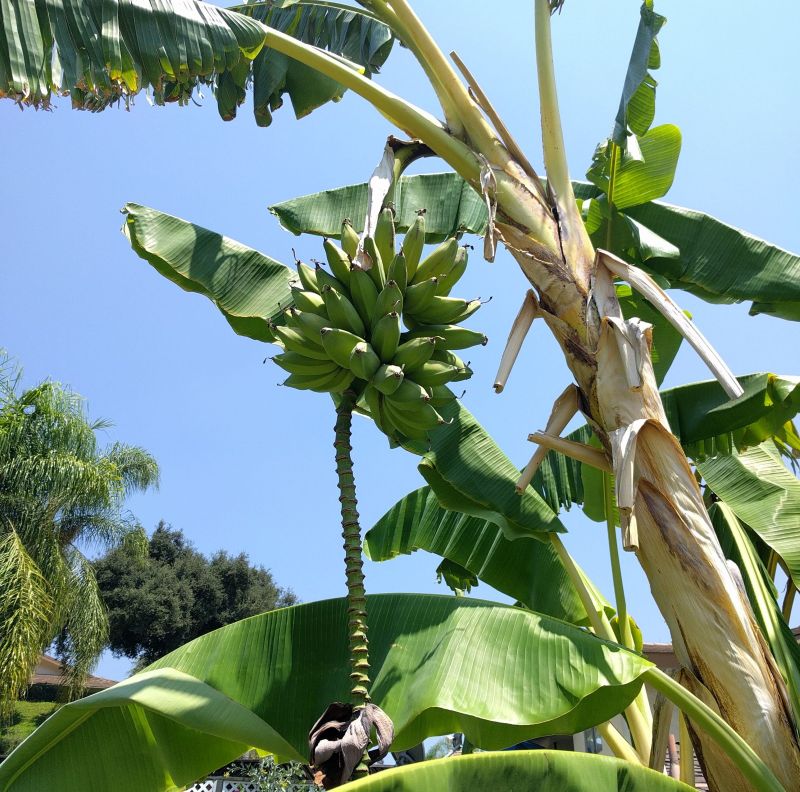
The banana stalk and leaves and flower and fruit grow out of a bulb-like base called a rhizome. That rhizome continually sprouts up new banana plants also. People usually call the group of banana plants emerging from a common rhizome a “mat,” but some call it a clump, and I sometimes think of it as a family.
What does it matter how bananas grow? You want to know that when you put in a single banana plant, in a few years you will have many banana plants.
That’s good and bad. The bad is that you may need to control the spread of the banana mat according to the space you have. You can do this easily by chopping off the baby banana plants with a shovel as they pop up.
The good is that your original banana plant is always multiplying itself. If you want more banana plants in another part of your yard, or if your neighbor wants some, you can grab a shovel and chop a small plant out of the mat and give it away or transplant it.
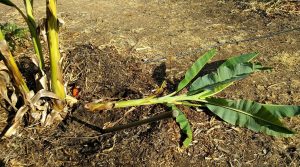
Starting banana plants
Bananas are an “over the fence” type of plant, as they say. Even though I’ve grown many banana plants, I’ve only bought one. All others have been given to me by friends and neighbors, or I’ve transplanted pups from my own banana mats.
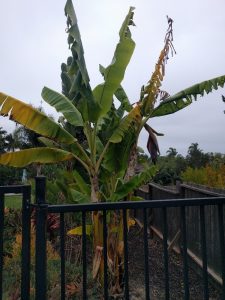
There is nothing tricky to transplanting a banana pup, also called a sucker. You need only to attempt to slice a chunk of rhizome along with the base of the sucker, as well as some roots if possible. The transplanted sucker may lose a couple leaves in its first weeks in the new spot, but that’s no big deal. You can even cut off all the leaves and the plant will soon start shooting out new ones. My habit is to chop the leaves in half just so the plant isn’t struggling to keep them alive, but I don’t really know if that’s the best way compared to doing nothing or cutting off all leaves. I only know that it works.
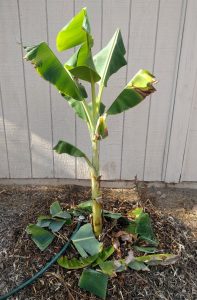
Within a year, that transplanted sucker will multiply into a mat, a family of banana plants.
I’ve always tried to limit my banana families to a mother, who is fruiting, and only two or three children.
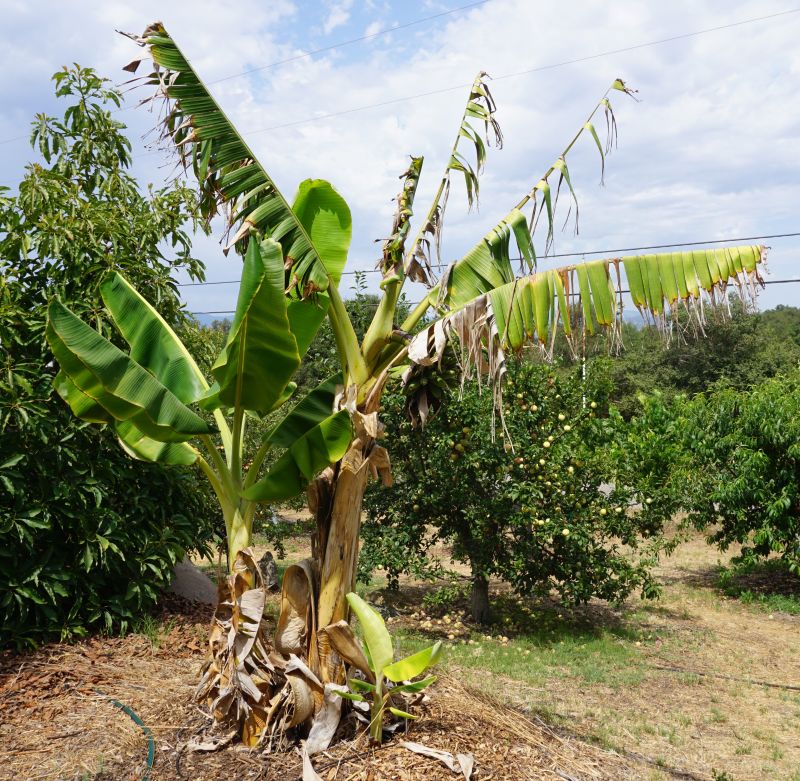
Four plants total seems to be an effective number for a banana mat. If more are allowed to grow, it’s said that they won’t fruit quite as well. I’ve never tested this personally, but from observing the banana mats of others it does seem true.
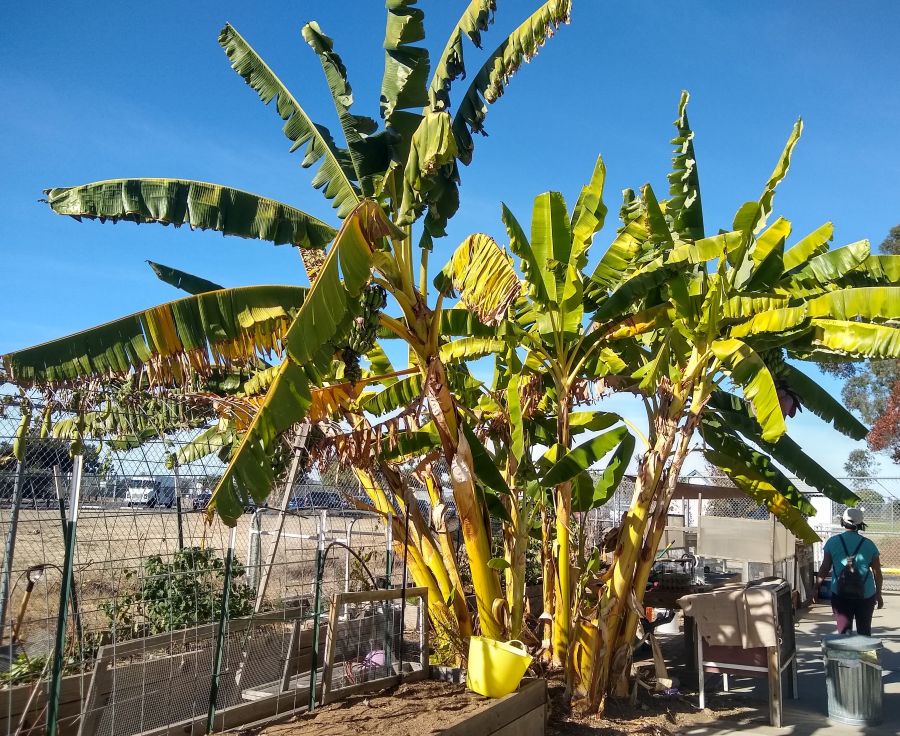
I also know that many commercial banana plantations only allow two plants in a mat. Obviously, they primarily care about maximum fruit production.
How long until a banana plant flowers and fruit ripens
In Southern California, it takes a banana plant longer to fruit compared to the tropics since we have a cooler winter in which our banana plants stop (or nearly stop) growing. Banana plants I’ve grown send out a flower sometime around 1.5 years after planting — it depends on the weather, variety, soil and watering. Then it takes up to six more months for the flower to become a bunch of mature bananas ready for harvest. It can take six months if the plant flowers in the fall, but it can take just a couple months if the plant flowers in the spring.
In summary, it takes about two years to go from planting a small banana plant to harvesting banana fruit.
What time of year does a banana plant flower? Whenever it feels like it. Bananas are a non-seasonal crop.
And so also bananas become ready to eat whenever they feel like it. Much flowering and fruit ripening happens spring through fall around here, but that’s only because banana plants in Southern California are very active in the spring through fall. Sometimes a plant will start fruiting in fall and then the baby bananas just sit there like statues all winter until it warms up in spring, when they resume maturing.
Harvesting bananas
Once a banana plant flowers and begins forming fruit along the flower stalk, some people do nothing.
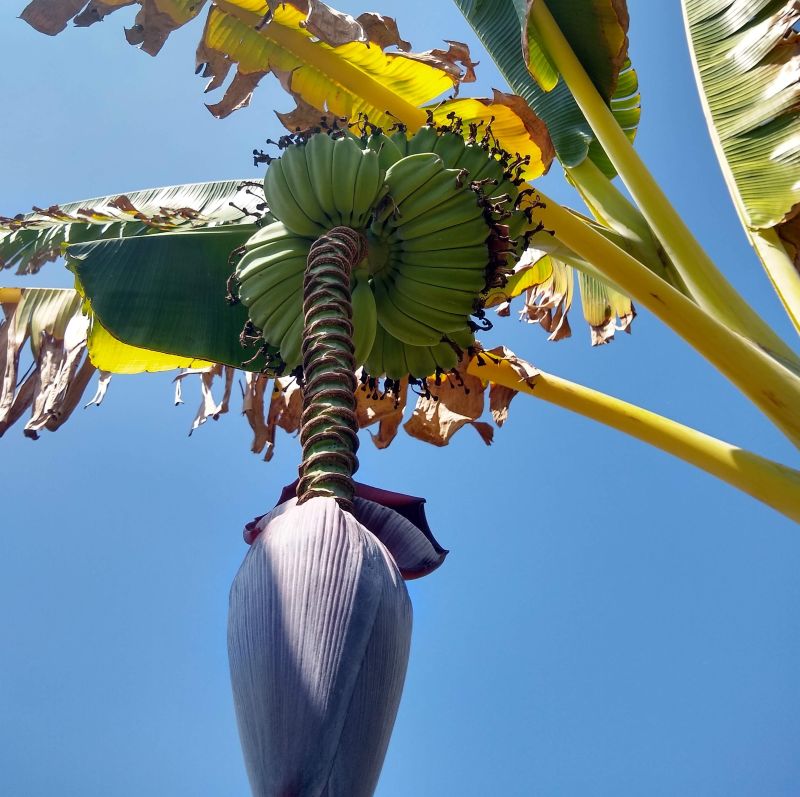
But others fiddle with the plant. They remove the dried tips from the bananas, they remove the flower bud (and some eat it), they cut the stalk.
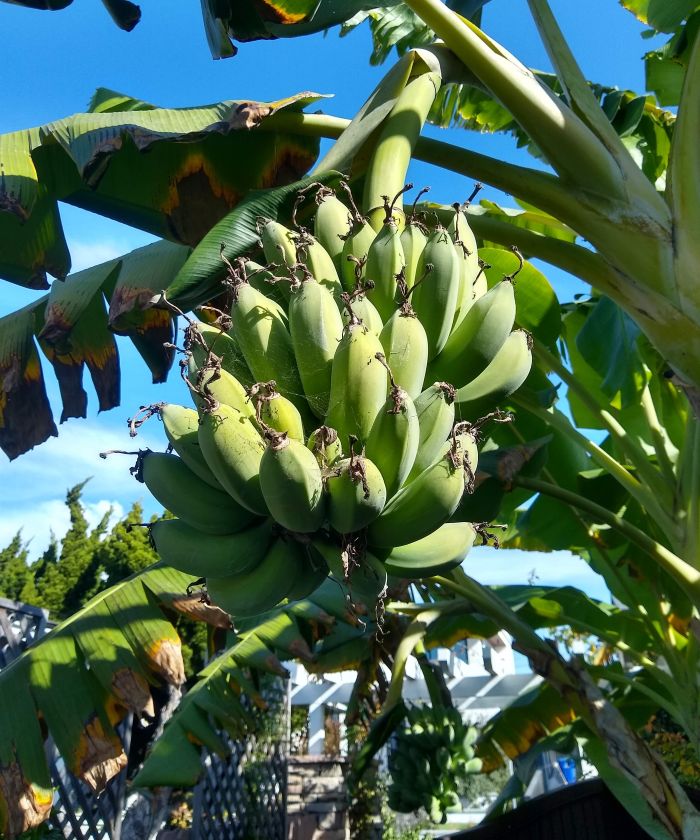
I’ve seen it and tried it many ways and don’t notice a clear difference in the effects on the maturing bananas, in terms of size or speed of growth. One good reason to cut the stalk off below the bananas is to reduce weight, as some varieties of banana are susceptible to toppling.
So what do you do when your banana plant flowers? Watch a most fascinating spectacle. A long thick stalk with a purple spearhead at the end thrusts out from the top of the trunk (technically called a pseudostem) and then groups (usually called “hands”) of bananas form along the stalk.
The number of bananas that grow on this single stalk can be upwards of 50, and the weight of them can get so heavy that the plant topples over. This only sometimes happens. If it seems likely, you can build a prop to support the stalk. A simple prop can be made with 2×2 wood that is connected in one spot with a bolt, such that it can be opened into the shape of an X. The X is wedged under the leaning plant.
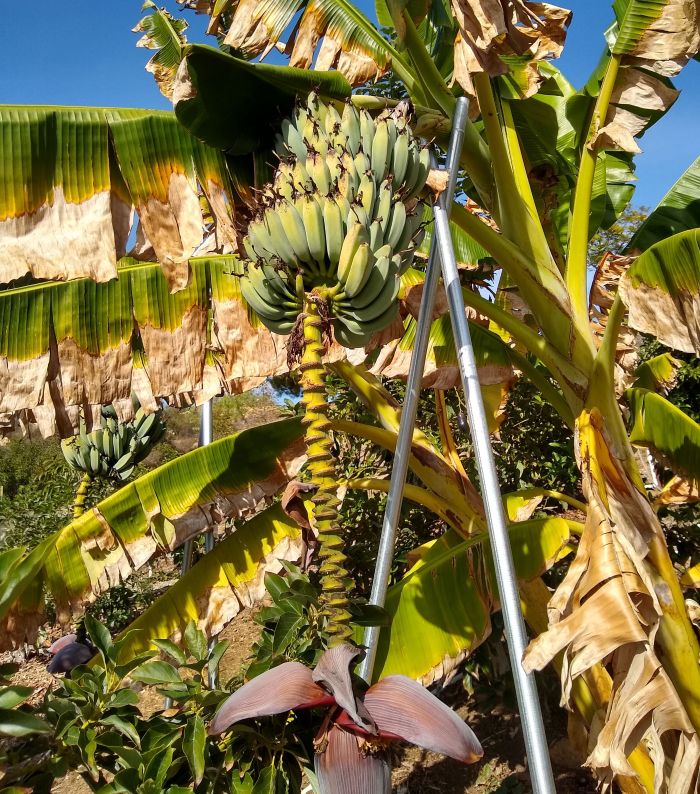
The bananas can be picked once they are plump (no longer so angular) but still green, as commercial bananas are, or you can leave them on the plant until they turn yellow and ripe.
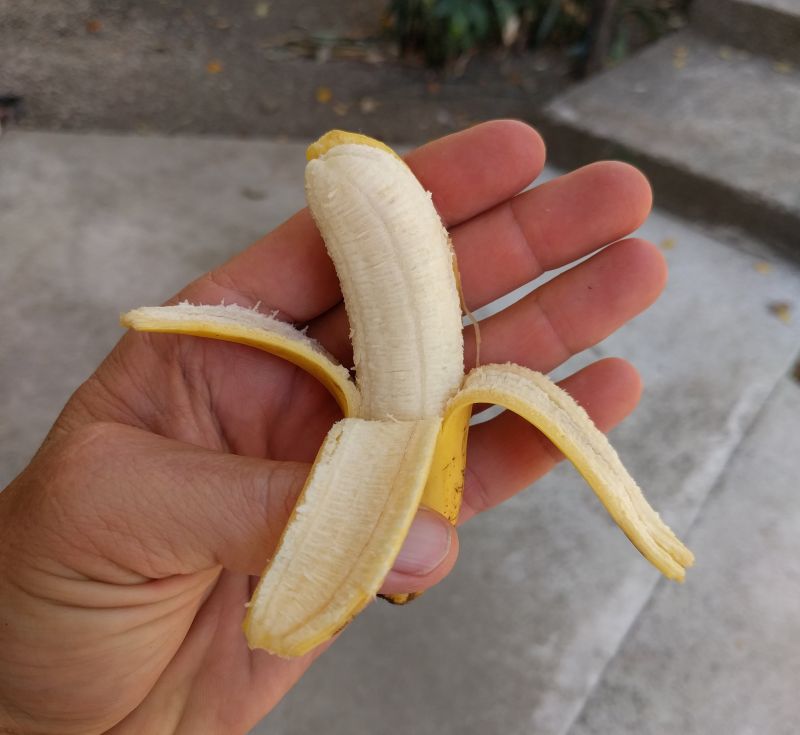
You can either cut off one banana at a time, starting at the top where the most mature ones are, or you can harvest one hand at a time. Individual bananas are called fingers, and groups of bananas attached to the stalk at the same place are called hands.
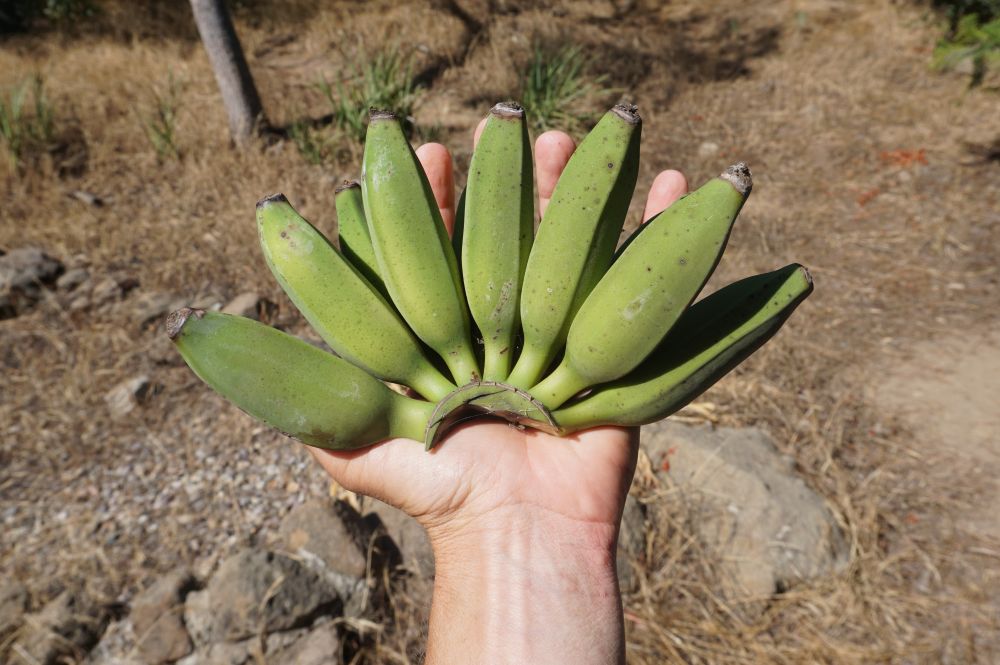
Or you can cut off the whole bunch at once and hang it somewhere, like in your garage or kitchen. This latter method can be more convenient with varieties that are tall and hard to reach.
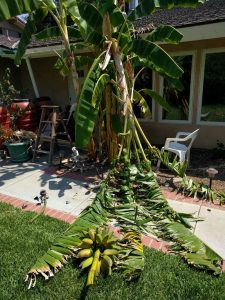
Sadly, a banana plant that has fruited is a banana plant that has fulfilled its end in life and will begin to die. So you can, after harvesting all the fruit, cut off that particular plant. A machete works well for this.
Gladly though, this mother plant has pups coming from the rhizome to take its place. The “family” is not dead, only that single mother plant that just fruited.
Watering and soil conditions that bananas like
To keep a banana plant happy in Southern California, the main thing you need to do is give it water in the dry months of the year. Bananas need little water during the winter here, when they briefly cease growing, but in the summer they love to drink. Give a banana ample water when the air is warm and it will unfurl new leaves before your very eyes.
The other thing bananas appreciate is fertile soil. Sure, many plants appreciate fertile soil, but bananas appreciate it more than most. They’ll grow and fruit even if you never fertilize them. I know this because I’ve done it and I’ve seen friends and neighbors do it. But I’ve also seen how much faster bananas grow in fertile soil, and how much bigger bunches they produce in such conditions.
Bananas’ love for soil fertility was once illustrated to me when I grew some around a compost pit. I had dug a pit and filled it with food and garden scraps, and then planted four bananas around the edge. Some months later I dug one of the plants out and found that it had far more roots on the side facing the pit, where it could feed on the compost.
A friend does something similar by occasionally digging a hole near his bananas and filling it with food scraps, covering it again with mulch. He also uses a fertilizer called ClassiCote 15-8-23. I’ve never used this product, but judging by the results he gets, it is doing no harm.
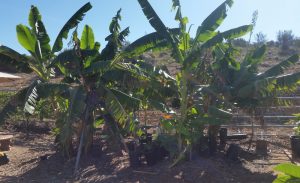
Pests and diseases
Speaking of digging, gophers love to eat the roots and rhizomes of bananas. I have lost a number of banana plants to gophers. You’ll see a banana plant leaning and then go lift it and it pulls right out of the ground because a gopher has chewed out its base.
So, trap the gophers, cage the banana plant, whatever you prefer. But know that gophers love to eat bananas. (I trap successfully using Cinch Traps.)
Banana varieties for Southern California
You may be surprised to learn that there are oodles of different kinds of bananas out there. The ones we buy at the grocery store are only one type called Cavendish. But when you grow your own, you’ll likely grow a different type and you’ll be able to experience new banana flavors and textures. You may like them more or less, but they won’t be just like the ones from the store: maybe smaller, maybe not as sweet, maybe firmer, maybe fatter, maybe with bigger seeds, maybe harder to peel, maybe with whiter flesh.
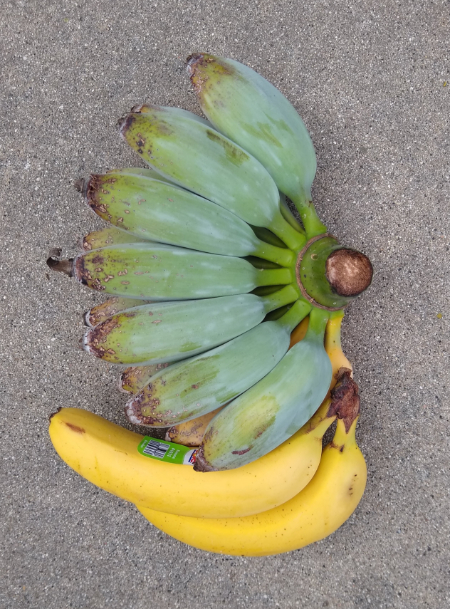
Besides the characteristics of the fruit, you should consider those of the plant. Varieties differ in their height especially. For example, Namwah plants only reach about 10 feet but Blue Java plants can reach over 20. The location of the banana bunches on each variety will likewise differ in height, making it easier or more difficult to protect and harvest.
For fruit production purposes, I prefer the shorter varieties like Namwah (also spelled Namwa and also called Pisang Awak and many other names), but taller varieties sure are attractive and they can better serve other functions like providing shade and privacy.
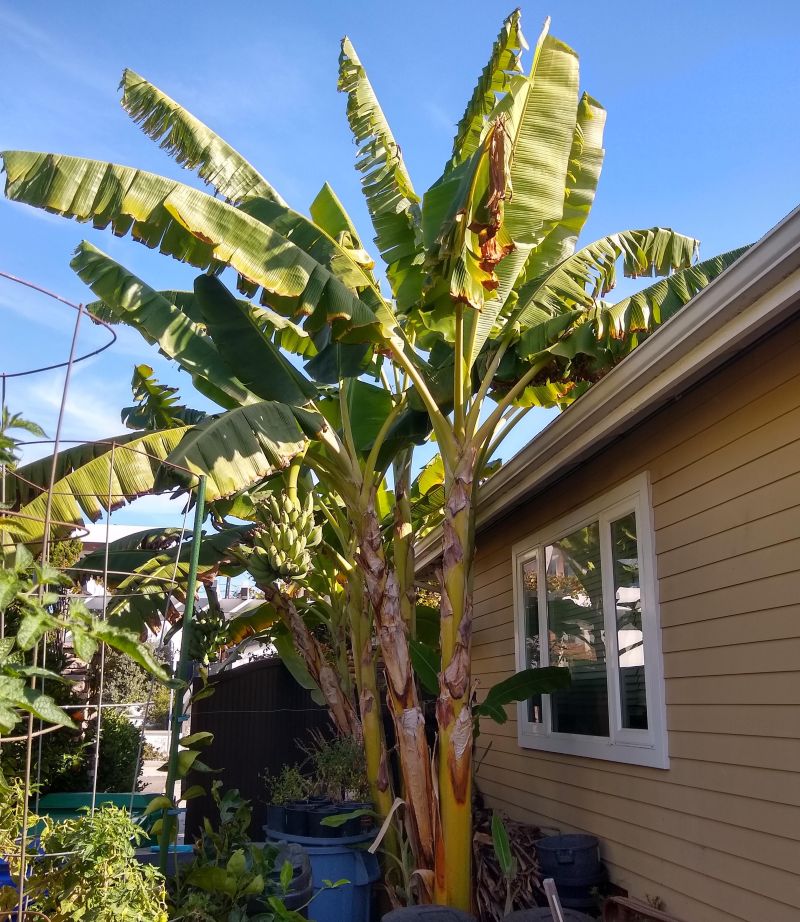
And some varieties are decorative.
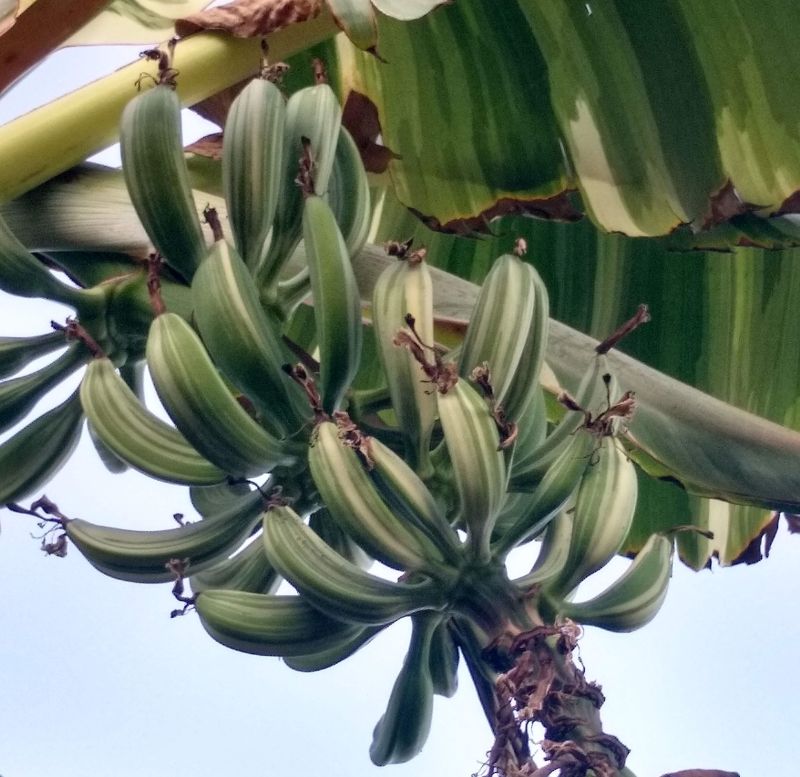
My recommendation for choosing a banana variety to grow is to try the fruit first if possible. I’ve grown many varieties in the past without first trying the fruit and regretted it: a couple years of space and work and water wasted because the fruit was inferior. Ways in which banana varieties can be inferior include fruit size, seed size, peelability, texture, pithy core, and flavor.
Rather than trusting a person’s or company’s description (such as, “Tastes like ice cream!”), I now only plant what I’ve tasted regardless of the claimed variety name. Banana variety names are numerous, dubious, and unreliable.
The favorite variety I am currently growing doesn’t even have a name, in a sense. My uncle Scott told me he had a tasty variety growing at his place in the San Gabriel Valley. He didn’t know the name; someone just gave him a pup. He gave me some fruit to try. They had everything I wanted in a banana: small size, easy peeling, smooth texture and excellent flavor. I got a pup and now it’s growing in my yard, known as “Uncle Scott’s banana.”
So I’ve decided to focus on growing more bananas to feed the beast that is my younger son. But we know what’s going to happen: By the time I’m bringing in bunches from the yard he’ll start waking up each morning asking, “Can I have an apple?”
Learn more about growing bananas in Southern California:
-Watch a talk called “Let’s Grow Bananas” given by Carol Graham, Master Gardener and member of the California Rare Fruit Growers; Carol has decades of experience growing bananas in north San Diego County
-Look through a slideshow called “Banana Basics” made by Jon Verdick, also located in San Diego County, and also a member of the California Rare Fruit Growers; see the handout that accompanies the slideshow here
All of my Yard Posts are listed HERE
There are no ads on The Yard Posts because of your support, for which I am grateful.

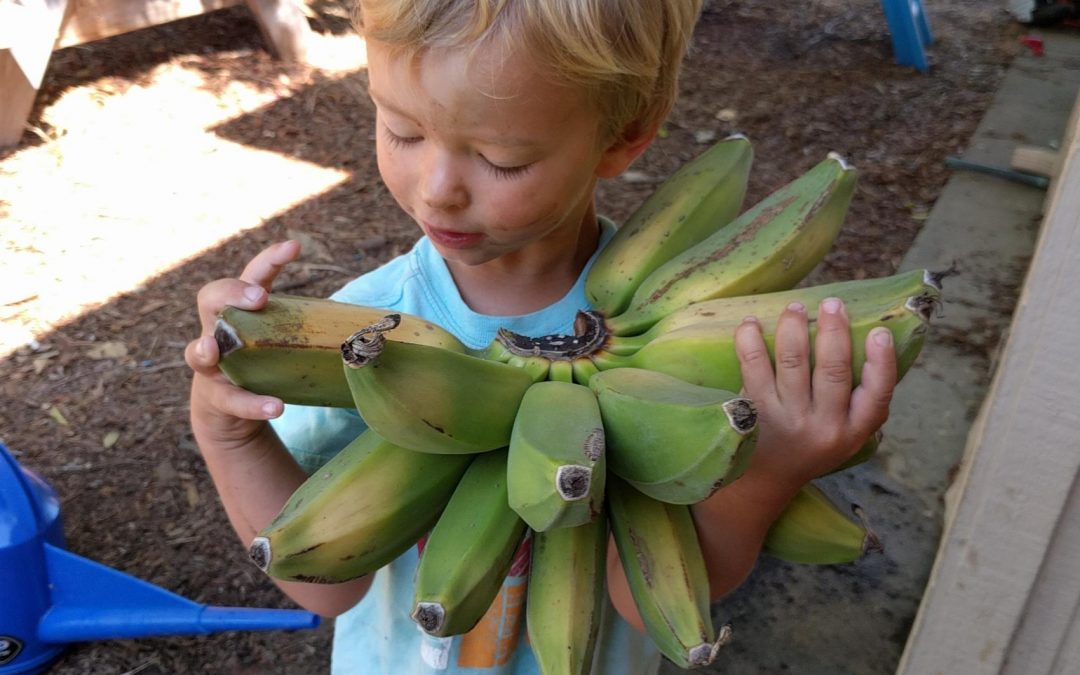


Great post! I loved being part of it! Now I will patiently wait for my bananas to ripen…
Thank Greg for an informative article on bananas!
Charles Anacker
Thanks Charles! Great to hear from you.
Loving this post! Thanks for all the info.
I live inland,SoCal n have a banana family, not sure what kind, I would say a Blue Java, small fruits, fat, sweet n appears blue gray in color I water frequently but really never fed the family now I know better. I get fruits but not much maybe 4 to 5 bunches per bundle of bananas, is that how you call them. Anyway, at the moment I have 3 trees that have fruits n another 1 that’s trying to come out but couldn’t. I see the banana blossom tip withering n still inside the pseudo stem, so maybe this is an abnormal one. I’ll try to take pics.
Recommendations on varieties to try?
I have a hard time making any recommendations because I’m not sure which varieties I have or which are which. I have given up trying to figure it out. Like I mentioned in the post above, almost all of mine have come from friends or neighbors and they weren’t always aware of the variety they were giving me.
But I like all that I have, and I THINK I have Ice Cream (also commonly called Blue Java), Goldfinger (also called FHIA-1), and Brazilian Apple (also called Apple, or Manzano). That’s another difficulty: banana varieties seem to always have multiple names. I have others that are totally unknown to me.
If you like, I can try to get you some fruit sometime and if you like it, get a pup for you from that mat.
I would like to try the apple one. I live in Oceanside zone 24. I just bought 4 little blue java pups. About to plant. Do u think I should them in bigger pots or right in the ground now? They are on ya foot tall. Should I wait till spring? When it’s warmer
Hi Tim,
Oceanside is a deceptive area. Even though it’s considered Sunset zone 24, there are parts that get surprisingly chilly in the winter such as near the harbor or inland up the San Luis Rey river a bit. I surfed around there and worked near the airport for a handful of years. Some of those parts are capable of getting cold enough to damage bananas.
So, if you live up a hill, then you’re probably safe planting those pups out. But if you live in a gully where it’s colder then I’d wait until March 1. If you wait, don’t bother putting them in bigger pots. Just wait. Bananas in Southern California just stall and don’t grow until it starts warming in February (unless they’re in some kind of artificially warm environment).
I live in North Poway and want to plant some banana trees. Where do I go to buy them?
Thank You!
Hi Mari,
I would first check Walter Andersen Nursery just off Scripps Poway Parkway near In-N-Out. If they don’t have any or many bananas in stock at the moment, they’ll surely be getting some in the next month or two. Might as well wait. Unless you’re in an exceptionally warm spot, the bananas will prefer to be planted outside after this series of cold storms and chilly, frosty mornings.
You can also check with Armstrong in Rancho Penasquitos. That’s probably fairly close to you too.
Greg,
So after waiting two years for my tree to fruit will I have to wait two more years for the pups that it produces to produce or will they fruit at different times?
Hi Drew,
I love the new gardening nickname. It’s a keeper.
That’s a good question. The pups under your new plant will start showing up later this summer. Once your original plant is tall and ready to send out a flower stalk, the largest pup will already be at least half as tall. Your original plant, the mother, will fruit and then by the time you have harvested all of its bananas, that pup that is second in line will be big and ready to send out a flower stalk itself within months.
So you’ll end up getting a bunch of bananas from the mat approximately once a year.
Hi Greg, I live in Irvine. My house came with glorious banana plants. We stuck a food stake in the ground by the roots and let this year’s bananas ripen on the plant to see if they would taste sweeter. Oddly, we got a swarm of bees under our patio umbrella just as the bananas were almost all ripe (top ones were all yellow, bottom ones still green). We stayed out of the backyard until someone could remove the bees. In just 2 days, our bananas had 20-40 of those huge beetles eating them!! So bizarre! I would have enjoyed it if the local wild parrots had eaten them – but not beetles!!
Hi Greg,
Thank you for sharing. How long is it for you / in your climate does it take to go from when you see the flowers to when you harvest? I’m guessing it depends a bit on the time of year the flower comes because winter dormancy can come into play. However, I’m still curious on the range you’ve seen and a rough average.
Hi Ken,
You’re exactly right about it depending on the time of year, but the approximate range is 3-6 months from flower emergence to eating bananas. Some say that covering the bunch with a plastic bag speeds this up, but I’ve never tried it so I can’t comment.
Hey! I live in Los Angeles and I have a dwarf namwa growing in a 20 gallon pot. I am unable to bring it inside, but I was wondering how often I need to water it in the winter and if I need to insulate it for the winter? Do I also need to cut all the leaves off?
Thanks!
Hi Carly,
Bananas don’t tend to use much water in the winter in Southern California, but the location of your plant might have slightly different requirements if it’s extra sheltered and warm and new leaves continue to unfurl through December and January. Mine have always stalled growth for a couple months in winter, and they don’t seem to want much water then too.
Just check the soil in the pot with your fingers and make sure it never totally dries out. Observe the leaves and make sure they never wilt from thirst.
It’s possible in parts of Los Angeles for winter nights to get cold enough to do some leaf damage to bananas. So if you can put the pot close to the house on extra cold nights that would help. Even if it gets some leaf damage, new leaves will grow rapidly once it warms in late winter.
Don’t cut any green leaves off. If you want, you can cut off dead, brown leaves anytime.
Are they ready!!?? I’ve been waiting two years to hear.
PS how do you keep them from not going brown?
Hi Greg,
I live in North Poway, trying to grow bananas.
I inherited the plant from the previous owner, so I am not sure
of its kind. Do you have any suggestions on any fertilizer.
Plant was originally in container, which I moved
into soil, but not growing well.
Hi Gopal,
I’m near you, just up the hill in Ramona. Probably, your plant doesn’t appear to be growing well right now just because of the time of year. In Southern California, bananas take a pause in growth during winter. Actually, they continue to grow very slowly, but nothing like they do in summer. Also, if we get a stretch of cold nights, the leaves may brown a bit. So overall, banana plants in Southern California look their worst exactly now, early February.
But don’t despair. The weather will warm and the days are getting longer such that by the end of the month or early March you’ll start to see new growth, and by about May your plant will look awesome.
It’s all about the temperature. Bananas need very little water in winter in Southern California, and they need no fertilizer either. Just let your plant rest. Once it warms up and the plant starts growing, then water and consider fertilizing it.
I’ve always just given my bananas compost, but as I mentioned in the post above, a friend who grows bananas very well fertilizes his with ClassiCote 15-8-23. In addition, he buries his food scraps near his banana mats. Try any of these fertilizing practices, but don’t feel the need until your plant starts growing again when the weather warms.
Hi Greg,
Thank you so much for your reply. As you suggested, now my bananas are growing well and looks more green. I haven’t started fertilizing, will watch for some more time and might try out more potash ones.
Can you please suggest where I can buy more plants. I thought of ordering from Florida Hill Nursery, but no good reviews.
Do you know any place where we can buy pups, I assume during this time they might be available.
Thank you
Gopal
Hi Gopal,
You should go to Walter Andersen’s there in Poway. If they don’t have the variety you want in stock, ask them to order it. They should be able to get many varieties for you.
Hi Greg,
Thank you for your suggestions, I was able to get three varieties of banana from Walter Andersen, Poway, and they are all happily growing now. I transplanted all of them from pot to soil.
Thank you
Ganesh
Great to hear, Ganesh!
Can I grow my banana tree in a large planter or does in need to be in the ground?
Hi Jenn,
You can fruit a banana plant in a large planter, yes. I’ve done so in the past.
I’ve been growing a variety named Raja Puri for 10+ years. I live in Simi Valley, CA. I always get a large amount of bananas, but they never plump out to where they become edible. They are dry with almost no meat. Any suggestions? Or should I just try another variety?
Hi Kim,
That’s curious. A friend grows Raja Puri and they seem to do well for him. He gave me some last summer and they were plump and edible.
Some ideas: Are yours watered a lot in summer? He waters his a lot. Do you leave the bunch on long enough before harvesting?
One more thing is that I’m skeptical about some banana plants being labelled correctly. Maybe you have something other than Raja Puri?
Hello. I just came across your website and wanted to plant a banana tree now in the beginning of May. I live in Valley village (north hollywood) in the San Fernando Valley. Is it too late to plant a small banana tree from Home Depot in my yard? or do i wait?
Hi Izzy,
Not at all. Now (May) is a fine time to plant a banana. It will get to growing rapidly this time of year.
To add to this question, would late June be OK?
Hi John,
Absolutely! I planted a banana a week ago and it’s doing great.
I just planted 3 here on a hillside in Whittier on June 13th and they are doing spectacular.
we are getting our first pod of bananas and are trying to find protection bags. Do you know where we can buy them here in san diego.
Hi Roy,
I’m sorry I don’t. But I also don’t know anyone who uses them around here and all of their bananas mature and ripen fine although the peels sometimes get a little scratched up.
Hello Gents,
Got a couple years now of about 10 banana pods up here on the hillside in Whittier, haven’t had any disturbances on any of the pods. Surprisingly, this is the one fruit (Aside from Citrus) that the critters have left alone. So much that i’ve planted some Platano Macho and some Mahio to add to the mix.
Greg,
Last year my daughter gave me apple banana pulp. Lives in Norwalk. My pup Grew super fast. It is now July an can see little fingers now.
I had about 5 pups growing. Transplanted 2 of them. Rest in pot. We have had 4-5 days in a row 100 plus. Doesn’t seems to hurt plant. Just water a lot.
Thanks for good info also for Avacado. My Mexicola last year over 500 plus.
Hi Tony,
We’ve also been 100 the last couple days, and I’m always amazed at how well bananas handle such heat. Like you said, just add water.
What did you do with all those Mexicolas?!
Greg,
The Mexicolas I grew here in Fresno, I picked about a shopping bags a week. Gave to my neighbor who returned donated to her church. Of course I ate 1 a day.
This year looks like very small crop. Very little sign of Bees.
By the way my friend who lives in Maui says Apple Banana cost around $ 1.59 pound.
But lucky neighbor has a plant.
Greg, we put in our first bananas In the spring of 2019. One of them flowered in November of 19 then, the winter here in Granite Hills brought some freezing weather and all of the leaves on that stalk died leaving the bunch of fruit behind. Now, the fruit is 3 – 4″ long, unchanged from the winter and some of them are starting to turn yellow on the stalk. I cut off the highest hand about 10 days ago, they sort of turned yellow, I tasted them and they were soft but flavorless.
After cutting off the hand, the remaining fruit is seeming to get a bit larger and plumper.
My thinking is that if there are no leaves on the stalk, the fruit isn’t going to mature properly, what say you?
Hi Peter,
I think this will just be a wait and see thing. Sometimes I’ve seen bananas mature a bunch well despite the plant getting some damage from heat or cold or falling over, but I’ve also seen bunches not mature properly after the plant has been damaged.
Thanks for your reply Greg. I was concerned that having that stalk and bunch in the mat with the five other stalks might inhibit their ability to fruit. We will give them another month or two and see what happens. Thanks again.
Hi Greg, thanks so much for the gorgeous layout, photos, and information.
I am in SD and wondering if there’s any chance of over-the-fencing a few pups
from you in the next few weeks – or from anyone else local who is reading this.
Looking for a couple of dwarves and a few with 15-20′ habit. You could contact me
via email…thanks!
Thanks for the great article! I have three banana plants in pots, about 3ft tall. They’re outgrowing their pots and I want to put them in the ground. I’m in Pomona, CA and we do get a bit of frost around January. If I translating the plants now, will they survive? Better to wait until spring? Thanks!
Hi Victoria,
You’re very welcome! Bananas stop growing about now; they’ll resume in late winter, whenever it warms up again. Because of this, you could keep your plants in their pots for the next couple months so they can be moved to shelter in case of serious cold.
But Pomona doesn’t get too cold so even if you planted them and they got some frost damage, it’s not going to be serious. Almost always around here, only the outer leaves are burned, and then when it warms up the plant begins to grow fast once again. The bananas almost certainly won’t be killed. Even in 25-degree nights at my place, small bananas have never been killed.
I purchased a single small Banana Tree of an Indian Variety 10-12 years ago and planted it in my front yard planting area in Rancho Bernardo (North part of San Diego). Over this time it has produced so many pups that I have banana trees growing all over my yard now. I get at least 2 big bunches of bananas every year. They are a smaller variety of bananas (not the big ones in the grocery store). Their texture is a little more firm than what is in the store, but our friends and family have really enjoyed them. We use them in smoothies & banana bread every year. My favorite thing is that they provide a beautiful tropical look in my yard and grow really fast. Once a month I snip off dead leaves to keep them green and lush. The bananas easily take 6 months to mature from the flower. I love my banana trees! Max height is 7-8 feet.
I have been experiencing some serious disease issues with a Gros Michel banana. The pseudostem is turning black and the new leaf is wilted and browning. Any ideas? I recorded it here:
https://www.youtube.com/watch?v=puOpqUriWFM
Sorry that I’m not experienced enough with banana diseases to give that a confident diagnosis. But you might be able to figure it out from the photos and descriptions on this page from the University of Hawaii: https://cms.ctahr.hawaii.edu/wangkh/Research-and-Extension/Banana-IPM/Banana-IPM-Guidebook
Thanks,
I just plucked off the wilted leaf and scraped off the black tissue, it is doing well so far.
Hi!!! I live In Winchester Ca, the banana plant survives in winter here without protection??
Hi Yari,
Possibly. I’ve seen large, productive bananas not far from you in Mead Valley. It will depend a bit on whether the spot is on a hill or in another spot that stays a little warmer on winter nights.
I’ve been growing them in Canyon Lake and they are thriving.
Hi I want to collect banana leaves to use as plates. Where could I get some from?
Hi Taffy,
If I were you, I would just keep an eye out as you drive around town. You’ll see many banana plants in yards in Southern California if you look for them. Then ask. Most people would be happy to cut off a few leaves for you.
I have been gifted with 4 small banana pups. We are in Vista near the Shadowridge golf course.Our yard came with lush tall Bird of Paradise on N, S, and W fence lines. I have planted one against the S fence, 1 on the W fence and two on the N fence walls. Gardener says they love water. I really enjoyed reading this page and all the useful information. We have lived in CA for less than a year and I have so much to learn about local gardening.
We’ve lived in our current Poway home 23 years (Standish Dr. In the Garden Road area). USDA zone 9b; Sunset Zone 21.
The house had 1 orange & 1 olive tree. We added >30 types of fruit trees & a water filtration for the house & yard (blocks chlorine, fluoride…etc).
3 avocado crops annually on our Haas tree (~ 700-1,000 avocados each yield)
Our Zutano is hanging by a thread…..
Our ice cream bananas do well on mounds in the lowest part of the Poway valley (next to the creek)
Our citrus orange (? Navel) produced year round on healthy tree….it seems to be dying now suddenly the last year ???
The house is from 1960 (63 years old) & we suspect it was planted with the house probably. What is the lifespan? We find conflicting info via Google search.
We are amateurs but enthusiasts 🙂
Hi Greg!
I planted an Ice Cream/Blue Java last year from a guy who has more 100 plants growing in Granite Hills, San Diego. It is still growing and more than 6′ tall. Last thing he said to me was “Let them turn very dark before you eat them, otherwise they taste a bit green” I let the 30 pound bunch he gave me get almost black. Sweet, delicious and still firm. Completely different from Cavendish.
About 8 years ago I wanted a Cherimoya tree and someone on Craiglist close by in, I think, 92115 was selling a Honey Hart tree. I drove over to his home and his front yard was loaded with banana trees of every variety. I purchased the Cherimoya tree from him that he grafted using a Z graft that was a beautiful perfect graft. I talked to him about the banana trees, but not much because I don’t have room to plant one and bananas were not my priority. I wish I could remember his location.
Hi Greg —
I’ve had a mat of burro bananas for about 20 years. A couple years ago gophers tore through and ate a lot of the rhyzomes, but then moved on the the bananas regrew. But now the pups are dying and even mid-size bananas. Something is destroying the corms. I don’t see signs of banana weevils, but when I pull out a dead plant there are no roots, and sometimes the bottom even looks kind of gnawed. Other times just rotten. There haven’t been new plants brought in. I don’t use pesticides elsewhere in the yard so trying to figure out if that’s the only solution, or … ? Thoughts? Appreciate your posts. Thank you